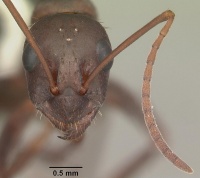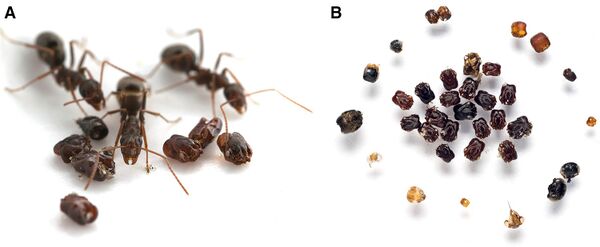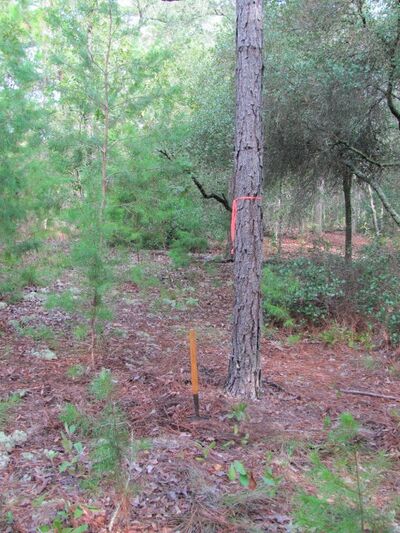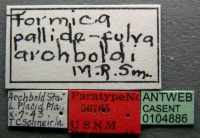Formica archboldi
| Formica archboldi | |
|---|---|

| |
| Scientific classification | |
| Kingdom: | Animalia |
| Phylum: | Arthropoda |
| Class: | Insecta |
| Order: | Hymenoptera |
| Family: | Formicidae |
| Subfamily: | Formicinae |
| Tribe: | Formicini |
| Genus: | Formica |
| Species: | F. archboldi |
| Binomial name | |
| Formica archboldi Smith, M.R., 1944 | |
A dark colored pallidfulva group species that is most abundant in north Florida. It also occurs in Georgia and Alabama. It shows a strong preference for preying on Odontomachus workers (Smith, 2018).
Photo Gallery
 A. F. archboldi workers from a freshly field-collected colony next to Odontomachus head and abdomen capsules found in their nest. B. A complete collection of all insect heads found in a single F. archboldi nest collected in August of 2017 from Lecanto, Florida. Odontomachus heads comprise the middle circle and are ringed by all other insect head capsules found in the nest, grouped by type. (From Smith, 2018, Fig. 1).
A. F. archboldi workers from a freshly field-collected colony next to Odontomachus head and abdomen capsules found in their nest. B. A complete collection of all insect heads found in a single F. archboldi nest collected in August of 2017 from Lecanto, Florida. Odontomachus heads comprise the middle circle and are ringed by all other insect head capsules found in the nest, grouped by type. (From Smith, 2018, Fig. 1). Nesting site (at shovel) of a Polyergus oligergus slave-maker with its slave Formica archboldi. Photo by Lloyd Davis.
Nesting site (at shovel) of a Polyergus oligergus slave-maker with its slave Formica archboldi. Photo by Lloyd Davis.
Identification
A member of the Formica pallidefulva group.
This dark brown to nearly black species has rarely been misidentified since its description in 1944 and is unlikely to be confused with any congener in the field. Mounted specimens that are shinier and less pilose than normal, or mislabeled ones (like those from “Virginia” in the Mayr collection), might be confused with darker color variants of Formica incerta or Formica pallidefulva without careful inspection. Occasionally other species, especially Formica biophilica, may stain black when mounted on pins, which could lead to confusion with F. archboldi. (Trager et al. 2007)
Keys including this Species
Distribution
Originally described from Archbold Biological Station in Highlands Co. FL, this species in fact appears to be more abundant in northern Florida. A characteristic ant of the uplands of peninsular Florida and the eastern panhandle, and also recorded by D. R. Smith (1979) as occurring in Georgia and Alabama. One collection of the Mayr collection labeled “Virginia” is doubtless mislabeled. This ant is characteristic in relatively undisturbed, long-leaf pine sandhills and in scrub or sand pine woodland. Less often, it may be found in the transition between these more open sandy habitats and drier portions of flatwoods, or southern live oak woodlands. In northern Florida, F. archboldi coexists with Formica dolosa and Formica pallidefulva in sandhill vegetation, but to the south on the Lake Wales Ridge (including the type locality), this ant becomes more typical of moist soil among pond-edge vegetation in swales within the white sand scrub vegetation, and is largely replaced in sandhill woodland by Formica pallidefulva. It is also reported from sandhill locations along the South Florida coasts, but probably is lacking from the Everglades. (Trager et al. 2007)
Latitudinal Distribution Pattern
Latitudinal Range: 35.16413889° to 26.03°.
| North Temperate |
North Subtropical |
Tropical | South Subtropical |
South Temperate |
- Source: AntMaps
Distribution based on Regional Taxon Lists
Nearctic Region: United States (type locality).
Distribution based on AntMaps
Distribution based on AntWeb specimens
Check data from AntWeb
Countries Occupied
| Number of countries occupied by this species based on AntWiki Regional Taxon Lists. In general, fewer countries occupied indicates a narrower range, while more countries indicates a more widespread species. |

|
Estimated Abundance
| Relative abundance based on number of AntMaps records per species (this species within the purple bar). Fewer records (to the left) indicates a less abundant/encountered species while more records (to the right) indicates more abundant/encountered species. |

|
Biology
Trager et al. (2007) - Within the pallidefulva group, this species is the most sensitive to human development and habitat alteration. During eight years of residence in Gainesville FL, J. Trager watched this species slowly disappear from sandhill woodland habitats near new housing developments, even when efforts were made to protect the native vegetation in green space around the houses. On the other hand, at Devil’s Millhopper Geological State Park during the same years, ecological restoration efforts consisting of selective species removal (cutting down mesic-adapted trees) and introduction of prescribed fire to maintain the open structure, resulted in a resurgence of F. archboldi (and incidentally, Formica dolosa) in the upland habitats of the site. A healthy population of F. archboldi could be considered an indicator of high natural area integrity, or at least a low level of habitat degradation, in Florida pine and pine-oak savannas and woodlands.
Nests are usually located beneath wiregrass clumps (or beneath beard grass or sedges in scrub habitats), and occur less frequently in bare soil, at the base of a shrub or under oak-leaf litter. The entrance is often marked with a small accumulation of plant fragments and/or grasshopper dung. Returning foragers watched for ½-hour intervals in the afternoon foraging period typically brought in more of these plant fragments and dung pellets than they did prey items (J. Trager, unpublished). Worker pupae are typically enclosed in a light tan cocoon, sexual pupae in a darke thicker cocoon. This species is the host of the Polyergus oligergus that uses F. archboldi as its host in Florida (Trager and Johnson 1985). F. archboldi lives outside the range of dulotic or other parasitic Formica species.
The myrmecophilous cricket Myrmecophila pergandei Bruner commonly inhabits the nests of F. archboldi. Outside the nest, F. archboldi gathers honeydew from living plant surfaces and from leaf litter, and also actively tends and defends Cinara aphids and Toumeyella scales on “grass-stage” long-leaf pine saplings. The defense of homopterans by F. archboldi was used, as they tended scales, to good effect by inducing workers to “attack” a termite offered on the end of a pine needle, then using the light-bodied prey as a marker to follow the worker returning to its nest. In two cases, this resulted in the discovery of a colony of the Polyergus lucidus variety mentioned above.
Foraging occurs mainly between 8 a.m. and noon and between 4 p.m. and dusk, from March through October. However, homopteran colonies are tended around the clock. Peak foraging activity occurs from April through June. Returning foragers carry a variety of freshly killed insects into the nest. Most of these prey items are herbivorous insects, but also among them are occasional individuals of Odontomachus brunneus Patton. Just how it is that this smaller and less ferociously built Formica captures and kills this well-armed ponerine has not been observed. Trager and Johnson (1985) report on habits of F. archboldi.
Sexuals occur in the nests from late April through June. The alates are not attracted to lights. They apparently fly in early morning, around sunrise. Females must quickly dealate and sequester themselves, as it appears no one has ever found either a newly mated female or incipient colony of this locally abundant ant.
Smith (2018) - Formica ants are not known to be prey specialists on other ant species, however, for the past 60 years, field observations on Formica archboldi in the southeastern United States have noted that their nests are scattered with body parts of Odontomachus trap-jaw ants. This study investigates the relationship between F. archboldi and Odontomachus. Through a series of behavioral experiments and a descriptive study of their chemical ecology, I find:
- (1) behavioral evidence that F. archboldi are more capable predators of Odontomachus in comparison to other Formica.
- (2) F. archboldi match the cuticular hydrocarbon profiles of the native species of Odontomachus that they occur with. This includes O. brunneus and O. relictus and the intraspecific variation found across Florida populations of O. brunneus.
- (3) F. archboldi do not display a prey retrieval preference towards hydrocarbon-matching Odontomachus as compared to mismatching.
- (4) F. archboldi that match Odontomachus hydrocarbon profiles do not receive lower levels of aggression than mismatching F. archboldi.
Beyond providing natural history insights into the relationship between these species, this study expands our knowledge of an important insect chemical phenotype. The intraspecific variability in F. archboldi cuticular hydrocarbon profiles is among the greatest reported for social insects and provides a unique case of how non-parasitic species can generate parasite-like chemical-mimic phenotypes.
Atchison & Lucky (2022) found that this species does not remove seeds.
Association with Other Organisms
 Explore: Show all Associate data or Search these data. See also a list of all data tables or learn how data is managed.
Explore: Show all Associate data or Search these data. See also a list of all data tables or learn how data is managed.
- This species is a host for the ant Polyergus oligergus (a dulotic parasite) (King & Trager, 2007; Trager, 2013; de la Mora et al., 2021) (as Polyergus lucidus in early records).
Castes
Worker
Images from AntWeb
   
| |
| Paratype of Formica archboldi. Worker. Specimen code casent0104886. Photographer April Nobile, uploaded by California Academy of Sciences. | Owned by USNM, Washington, DC, USA. |
Queen
Images from AntWeb
   
| |
| Queen (alate/dealate). Specimen code casent0103924. Photographer April Nobile, uploaded by California Academy of Sciences. | Owned by ABS, Lake Placid, FL, USA. |
Male
Images from AntWeb
    
| |
| Male (alate). Specimen code casent0103925. Photographer April Nobile, uploaded by California Academy of Sciences. | Owned by ABS, Lake Placid, FL, USA. |
Nomenclature
The following information is derived from Barry Bolton's Online Catalogue of the Ants of the World.
- archboldi. Formica pallidefulva subsp. archboldi Smith, M.R. 1944d: 16 (w.) U.S.A. Trager, MacGown & Trager, 2007: 615 (q.m.). Combination in F. (Neoformica): Creighton, 1950a: 549. Raised to species: Creighton, 1950a: 549.
Unless otherwise noted the text for the remainder of this section is reported from the publication that includes the original description.
Description
Worker
Trager et al. (2007) - The most evidently sculptured and the smallest member of the group, characteristic of Florida’s upland pine and scrub habitats. F. archboldi has the largest eyes relative to head size of all species in this group. Head and gaster very dark reddish brown, appearing blackish or dark gray-brown in the field; mesosoma often a little lighter than head, and sometimes both lighter than gaster. Gastral dorsum at most weakly shining, sheen dulled by numerous, shallow impressions (foveolae) and pubescence composed of moderately dense grayish appressed microchaetae. Dorsal sclerites of mesosoma and gaster usually with moderately abundant, short, erect, brownish-gray erect macrochaetae, and pale grayish appressed microchaetae. Erect macrochaetae on mesosoma and usually on gaster are relatively short, straight and flattened with rounded, blunt or abruptly tapering tips; less often, at least some of those on gaster a bit longer and slightly curved, these less flattened and tapering.
- Trager et al. 2007
Queen
Trager et al. (2007) - Color, gastral pubescence and sculpture like the workers’, with the usual differences in size. There is tessellation on the upper portion of head, pronotum, sides of mesothorax, propodeum and gastral dorsum; wings, when present, clear brownish to clear smoky gray. Pilosity longer and more flexuous than that of worker.
Male
Trager et al (2007) - Pubescence and pilosity abundant; mesosomal dorsum dull-punctate; entire body black, legs reddish brown or mesosoma lighter, dusky yellowish brown; wings clear brownish to clear smoky gray; pilosity like that of queen; gastral pubescence pale brownish yellow and very dense. Averages smaller than the otherwise difficult-to-distinguish males of Formica dolosa and Formica biophilica.
Type Material
Formica pallidefulva subsp. archboldi [Examined. Syntype workers] four workers on two pins, labeled, Florida: Archbold Biological Station, 10 miles south Lake Placid, Fla. X-7-43 T. C. Schneirla. Paratype No. 56765 U.S.N.M. (Museum of Comparative Zoology).
Etymology
This species is named after Richard Archbold, founder of Archbold Biological Station, Lake Placid, Florida, the type locality.
References
- Atchison, R. A., Lucky, A. 2022. Diversity and resilience of seed-removing ant species in Longleaf Sandhill to frequent fire. Diversity 14, 1012 (doi:10.3390/d14121012).
- Bolton, B. 1995b. A new general catalogue of the ants of the world. Cambridge, Mass.: Harvard University Press, 504 pp. (page 191, catalogue)
- Borowiec, M.L., Cover, S.P., Rabeling, C. 2021. The evolution of social parasitism in Formica ants revealed by a global phylogeny. Proceedings of the National Academy of Sciences 118, e2026029118 (doi:10.1073/pnas.2026029118).
- Creighton, W. S. 1950a. The ants of North America. Bulletin of the Museum of Comparative Zoology 104: 1-585 (page 549, Combination in F. (Neoformica), and raised to species)
- de la Mora, A., Sankovitz, M., Purcell, J. 2020. Ants (Hymenoptera: Formicidae) as host and intruder: recent advances and future directions in the study of exploitative strategies. Myrmecological News 30: 53-71 (doi:10.25849/MYRMECOL.NEWS_030:053).
- Ipser, R.M., Brinkman, M.A., Gardner, W.A., Peeler, H.B. 2004. A survey of ground-dwelling ants (Hymenoptera: Formicidae) in Georgia. Florida Entomologist 87: 253-260.
- Larabee, F.J., Suarez, A.V. 2014. The evolution and functional morphology of trap-jaw ants (Hymenoptera: Formicidae). Myrmecological News 20: 25-36.
- MacGown, J.A., Booher, D., Richter, H., Wetterer, J.K., Hill, J.G. 2021. An updated list of ants of Alabama (Hymenoptera: Formicidae) with new state records. Transactions of the American Entomological Society 147: 961-981 (doi:10.3157/061.147.0409).
- Perfilieva, K.S. 2023. Cretaceous-Burmese-amber ants: Morphological features and community structure. Biology Bulletin Reviews 131, 38–54 (doi:10.1134/s207908642301005x).
- Smith, A.A. 2018. Prey specialization and chemical mimicry between Formica archboldi and Odontomachus ants. Insectes Sociaux 66: 211–222 (doi:10.1007/s00040-018-0675-y).
- Smith, M. R. 1944d. Additional ants recorded from Florida, with descriptions of two new subspecies. Fla. Entomol. 27: 14-17 (page 16, worker described)
- Trager, J.C., MacGown, J.A., Trager, M.D. 2007. Revision of the Nearctic endemic Formica pallidefulva group (pp. 610-636). In Snelling, R.R., Fisher, B.L. & Ward, P.S. (eds). Advances in ant systematics: homage to E.O. Wilson – 50 years of contributions. Memoirs of the American Entomological Institute 80: 690 pp.
- Tschinkel, W.R. 2015. The architecture of subterranean ant nests: beauty and mystery underfoot. Journal of Bioeconomics 17:271–291 (DOI 10.1007/s10818-015-9203-6).
References based on Global Ant Biodiversity Informatics
- Addison D. S., I. Bartoszek, V. Booher, M. A. Deyrup, M. Schuman, J. Schmid, and K. Worley. 2016. Baseline surveys for ants (Hymenoptera: Formicidae) of the western Everglades, Collier County, Florida. Florida Entomologist 99(3): 389-394.
- Annotated Ant Species List Ordway-Swisher Biological Station. Downloaded at http://ordway-swisher.ufl.edu/species/os-hymenoptera.htm on 5th Oct 2010.
- Del Toro, I. 2010. PERSONAL COMMUNICATION. MUSEUM RECORDS COLLATED BY ISRAEL DEL TORO
- Deyrup M., C. Johnson, G. C. Wheeler, J. Wheeler. 1989. A preliminary list of the ants of Florida. Florida Entomologist 72: 91-101
- Deyrup, M. 2003. An updated list of Florida ants (Hymenoptera: Formicidae). Florida Entomologist 86(1):43-48.
- Deyrup, M. and J. Trager. 1986. Ants of the Archbold Biological Station, Highlands County, Florida (Hymenoptera: Formicidae). Florida Entomologist 69(1):206-228
- Forster J.A. 2005. The Ants (hymenoptera: Formicidae) of Alabama. Master of Science, Auburn University. 242 pages.
- Ipser R. M. 2004. Native and exotic ants (Hymenoptera: Formicidae) of Georgia: Ecological Relationships with implications for development of biologically-based management strategies. Doctor of Philosophy thesis, University of Georgia. 165 pages.
- Ipser, R.M., M.A. Brinkman, W.A. Gardner and H.B. Peeler. 2004. A Survey of Ground-Dwelling Ants (Hymenoptera: Formicidae) in Georgia. The Florida Entomologist 87(3) 253-260.
- Johnson C. 1986. A north Florida ant fauna (Hymenoptera: Formicidae). Insecta Mundi 1: 243-246
- King J. R., and J. C. Trager. 2007. Natural history of the slave making ant, Polyergus lucidus, sensu lato in northern Florida and its three Formica pallidefulva group hosts. Journal of Insect Science 7: Article 42 (available online: insectscience.org/7.42): 14 pp.
- Lubertazzi D. and Tschinkel WR. 2003. Ant community change across a ground vegetation gradient in north Floridas longleaf pine flatwoods. 17pp. Journal of Insect Science. 3:21
- Trager, J. and C.Johnson. 1985. A slave-making ant in Florida: Polyergus lucidus with observations on the natural history of its host Formica archboldi (Hymenoptera: Formicidae). The Florida Entomologist 68(2):261-266.
- Whitcomb W. H., H. A. Denmark, A. P. Bhatkar, and G. L. Greene. 1972. Preliminary studies on the ants of Florida soybean fields. Florida Entomologist 55: 129-142.
- Pages using DynamicPageList3 parser function
- Photo Gallery
- North temperate
- North subtropical
- Cricket Associate
- Host of Myrmecophila pergandei
- Ant Associate
- Host of Polyergus oligergus
- Species
- Extant species
- Formicidae
- Formicinae
- Formicini
- Formica
- Formica archboldi
- Formicinae species
- Formicini species
- Formica species
- Ssr





